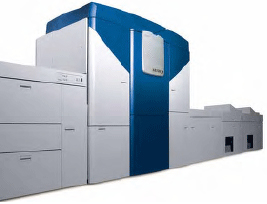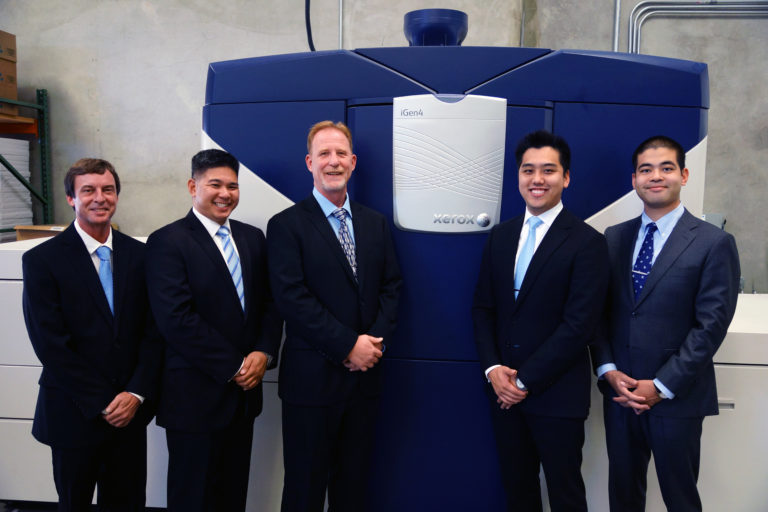In 2009 Xerox commissioned an independent Comparative Photographic Image Print Quality Analysis of print output from several digital presses and conventional photo processing.
This report from the SpencerLab Digital Color Laboratory concluded, “the 4-color Xerox iGen4 Photographic Image Quality emerged as overall best of the digital presses, barely edging out our previous best, the 6-color HP Indigo Press 5500.” 
To really understand what that means you have to understand the photo market. Because of cost and production speed, no company I have come across in this business uses more than four colours in photo production. This means that the SpencerLab assessment shows the Xerox iGen4 is now the best product available for digital photo imaging. Their summary stated the following, “The Xerox iGen4 offered the overall best photographic image quality among the tested digital press solutions for photo book applications, and is a competitive option to conventional photo processing.”
I spoke to Andy Tribute, a leading Graphic Arts consultant, and asked him to comment: “You have to admit, HP has done a great job at marketing their liquid toner as ink to the Graphic Arts and Photo Industry. For some reason Printers and Photofinishers believed this and they forgot that consumers of photobooks, whom 85% of the time are women, couldn’t tell the difference!”

That is changing now as Photofinishers and Printers are realising the output capacity of the iGen4 unassisted. I’ve visited a Photofinisher in the US who operates both presses in the same factory. There is one operator for 3 iGen4’s and one operator and an engineer for 3 HP Indigos. Then there’s another Photofinisher in Western Europe who tells me that his iGen4 is 25% more productive than his other 40 engines. That’s a lot of output and a lot of cost saving for any business! I could go on and on….
Is Xerox finally pulling their great history of innovation and inventions into their marketing material or is the market seeing through the smoke and mirrors?
What do you think…
17 Comments
Comments are closed.


Isn’t that a rather patronising comment regarding the quality judgement of consumers, and in particular, women?
Women generally have superior colour vision and a far lower incidence of colour blindness than men.
Andy’s comment also implies that printers and photofinishers have bought equipment based on the manufacturers marketing claims without carrying out their own assessments of fitness for purpose.
Hey Barney
Please don’t give Andy a hard time he’s not Sexist! I think his point was Consumers (who are women) didn’t care if output was printed using liquid toner or Xerox toner which is probably true!
As a woman myself who fits the target audience, I can confirm the most important thing to me is to receive the book on time, in the right order and professionally finished.
The marketing comment was mine, it is true HP have done a great job with marketing liquid toner as superior to our toner.
On the other hand our marketing team at Xerox (ME!) have not done a great job at sharing our innovation and inventions in general.
For photo applications, we have software that can add words within images, automatic image enhancement whilst ripping high res images without impacting speed etc. Our ability to deliver colour consistency without skilled operators to name a few.
All these things at no extra cost to our customers but they for our customers hard cash savings!!!
I will send you Andy’s full article on the spencer report analysis separately. I think his brief comments here will become clearer!
See you soon!
Regards
U.x.
I’m sure if HP paid for the SpencerLab report, the results would have been different.
Hey Curtis,
What company do you work for ?
First I would agree with Curtis that the result might relay to the “man with the money” but no dought, the iGen4 produces pretty good quality (NOT better than an HP). The main thing about this is, that it is much more productive than an HP. Some of the european customer I have talked to told me the story of 25% more. And that’s the BIG one behind it all. Comparable quality and being much more productive!
Curtis, et. al.,
Please see a response below from David Spencer, CEO from Spencer Labs:
SpencerLab’s research findings in 2009 detailed in the white paper “Xerox iGen4 Photographic Image Print Quality— One of the Best options available today” do not conflict with our 2007 research findings documented in the white paper, “Digital Presses Rise to a New Challenge—HP Indigo press 5500 leads in Photographic Print Quality,” commissioned. by Indigo. Rather, differences reflect product and methodology advances with time. Both reports are freely available on http://www.spencerlab.com.
If you haven’t already done so, please download and read the iGen4 White Paper, and let us know on what basis — if any — you allege that our analysis is biased. Our Methodology is described in detail. You may have had some experience with biased research — but not with SpencerLab — and our clients acknowledge this in every contract.
In case you haven’t read the actual white paper, it begins: “Digital presses have come a long way in the two years since we last had an opportunity to evaluate their Photographic Image Print Quality. Print quality has improved still further, making it more difficult to narrow down and pick the best. Out of the several high quality options available in the market today, the 4-color Xerox iGen4 Photographic Image Print Quality emerged as overall best of the digital presses, barely edging out our previous best, the 6-color HP Indigo Press 5500.” [emphasis added]
Key Findings included: “… the Xerox iGen4 offered the overall best photographic image quality among the tested digital press solutions for photo book applications, and is a competitive option to conventional photo processing. The overall best digital press printing performance of the Xerox iGen4 was highlighted by very impressive Sharpness and Neutral Gray rendition, and exceptional Realism of both Foliage and Sky & Water colors. Richness was good, while some opportunity for improvement was noted in Smoothness and Realism of Fleshtones.”
A chart on page 2 of the White Paper shows where and by how much we found the 4-color iGen4 to be advantaged or disadvantaged relative to the 6-color Indigo Press 5500 and the 4-color Indigo Press 7000 in attributes such as Realism (Foliage, Sky & Water, Fleshtones) Richness, Sharpness, Smoothness, and Neutral Gray rendition. The weighting of these attributes emulates consumer photo preferences, derived from our experience conducting worldwide consumer focus groups. The iGen4 barely edged out the 6-color Indigo Press 5500, and was superior to the 4-color Indigo Press 7000 (which did not offer photographic 6-color operation). Let me hasten to point out that the Indigo Press 5500 is most often used in only 4-color mode, as the added productivity is more important than the incremental quality loss — productivity is, of course, another advantage of the iGen4.
We also found, “Lack of operator training and non-optimized RIP/workflow can significantly deteriorate the actual print quality achieved by any device.”
I hope you come to understand that integrity is one of SpencerLab’s greatest assets, and that HP as well as Xerox and many other industry leaders as well as corporations continue to be trusting clients as we enter our 22nd year.
I do not work for HP; I am a critic of them as well. I work for a company that produces photo books with Xerox and HP products. Each engine has its strengths and weaknesses. My point is that the comparisons were subjective; based on procedures and test images that I question. I could easily create a questionnaire and test images that could take advantage of a press’ color space, color management, ink density, image resolution, and print flaws to make the other press’ output appear inferior compared to a selected target print.
I believe, the test image appears to contain more elements that favor the iGen’s print quality. Was the test file independently created, without any input from Xerox? Did Xerox have input in determining the target print, papers, and companies that created the output?
In my opinion, the subjective comparison is weighted in the favor of the iGen’s strengths. Was the questionnaire created without Xerox input?
The findings in the SpencerLab report, from my experience, is questionable.
Hi Curtis!
I agree that each product has their strengths and weaknesses— That’s why you never see us printing the same images at tradeshows 🙂 (That’d be the ultimate test I bet!)
I think your concerns about images used in the study are completely valid. I myself always question the same things with anything I read… and that’s a good habit to have!
The companies used in the study were recommended by the manufacturers. They each provided two sites they believed would provide photo book quality prints representative of their device. The papers used were also vender approved, and the report states on page 2 that the images were from Spencer Lab’s Test Suite. Looking at the report I don’t recognize any of these images (from tradeshows or anything), but to validate I have sent a note asking if Xerox had input into the imagery.
In my personal opinion, I think our ultimate goal with having a study of this depth done is to see where we stand against others. We hope the results will be good, and if they aren’t… we know where we need to improve our product for the next time around. If we chose test images and procedures favoring the iGen, then I don’t think that really helps anyone in the long run.
I’ll let you know what I find out. Thanks for all of your feedback (and for being a Xerox customer)!
Xerox technology is definitely competing in this space with HP Indigo. At PMA the Docucolor 250 beat out the Indigo on a image quality test!! That’s Xerox low end beating out HP high end product, so HP isn’t really leading anymore in the photo market.
Curtis-
Xerox did have input, but the final choice of all the images and the paper used was SpencerLabs. There were images selected that we would not have chosen, so the capabilities of the iGen were definitely put to the test.
Andrea-
That DocuColor 250 win was in 2007. In 2009, the Xerox DocuColor 242, Xerox 700, AND iGen4 captured all 3 of the DIMA Shoot-Out Awards!
[…] Digital Printing Hot Spot I work for a company that produces photo books with Xerox and HP products. Each engine has its strengths and weaknesses. My point is that the comparisons were subjective; based on procedures and test images that I question. […]